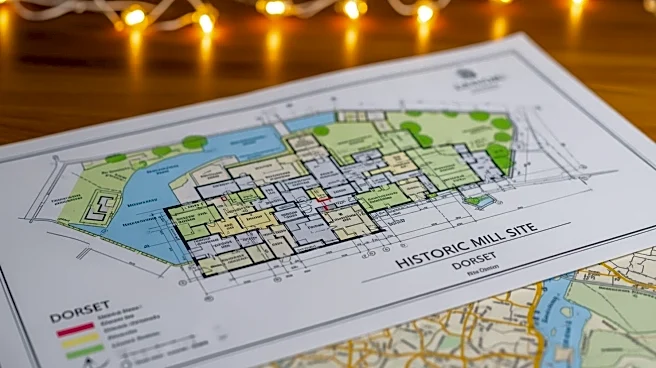What's Happening?
KPPC Planning Consultants, based in Bournemouth, has successfully won an appeal to develop 16 homes on a historic mill site in the Dorset green belt. The appeal was granted by the Planning Inspectorate,
overturning a previous decision by Dorset Council to refuse the application. The site, Morden Mill and Farmhouse, located off the A35 road near Poole, includes buildings dating back to the 11th Century, with the current structures erected in the 18th Century. Both buildings are Grade II listed and considered of significant national importance. The appeal was lodged under section 78 of the Town Country Planning Act 1990, with KPPC acting for Smartin Developments Limited, alongside Scott Worsfold Architects and Urban Designers. The inspector, Oliver Marigold, stated that the development would secure the future of the mill and farmhouse as heritage assets, meeting the 'very special circumstances' test required for green belt development.
Why It's Important?
The successful appeal is significant as it facilitates the restoration of important heritage assets in Dorset, ensuring their preservation for future generations. The development will not only breathe new life into the historic mill and farmhouse but also provide much-needed housing in the area. This decision highlights the balance between heritage conservation and development needs, demonstrating how thoughtful design can integrate new housing within historically significant sites. The project is expected to contribute positively to the local economy by attracting investment and potentially increasing property values in the vicinity. It also sets a precedent for similar developments in green belt areas, where heritage conservation can justify new construction.
What's Next?
The development will proceed under specific conditions set by the inspector, including the purchase of nitrate credits, a Construction Traffic Management Plan, and a Landscape and Ecological Management Plan. KPPC and its partners, including Scott Worsfold Architects, will begin the process of implementing the design and construction plans. The project team will work closely with local authorities and stakeholders to ensure compliance with all conditions and to address any community concerns. As the development progresses, it will be closely monitored to ensure that the restoration and construction meet the high standards set by the planning appeal.
Beyond the Headlines
This development raises broader questions about the role of planning appeals in balancing heritage conservation with modern development needs. It underscores the importance of maintaining historical sites while accommodating growth and housing demands. The decision may influence future planning applications in green belt areas, encouraging developers to consider heritage preservation as a viable path to gaining planning approval. Additionally, it highlights the potential for collaboration between architects, planners, and developers in creating projects that respect historical significance while addressing contemporary needs.












